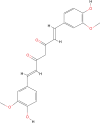Phytochemicals modulate carcinogenic signaling pathways in breast and hormone-related cancers
- PMID: 26273208
- PMCID: PMC4532173
- DOI: 10.2147/OTT.S83597
Phytochemicals modulate carcinogenic signaling pathways in breast and hormone-related cancers
Abstract
Over the years, nutrition and environmental factors have been demonstrated to influence human health, specifically cancer. Owing to the fact that cancer is a leading cause of death worldwide, efforts are being made to elucidate molecular mechanisms that trigger or delay carcinogenesis. Phytochemicals, in particular, have been shown to modulate oncogenic processes through their antioxidant and anti-inflammatory activities and their ability to mimic the chemical structure and activity of hormones. These compounds can act not only by influencing oncogenic proteins, but also by modulating noncoding RNAs such as microRNAs and long noncoding RNAs. Although we are only beginning to understand the complete effects of many natural compounds, such as phytochemicals, researchers are motivated to combine these agents with traditional, chemo-based, or hormone-based therapies to fight against cancer. Since ongoing studies continue to prove effective, herein we exalt the importance of improving dietary choices as a chemo-preventive strategy.
Keywords: cancer; curcumin; dietary polyphenols; epigallocatechin gallate; genistein; natural compounds; noncoding RNA.
Figures





Similar articles
-
Contribution of Non-Coding RNAs to Anticancer Effects of Dietary Polyphenols: Chlorogenic Acid, Curcumin, Epigallocatechin-3-Gallate, Genistein, Quercetin and Resveratrol.Antioxidants (Basel). 2022 Nov 28;11(12):2352. doi: 10.3390/antiox11122352. Antioxidants (Basel). 2022. PMID: 36552560 Free PMC article. Review.
-
Molecular mechanisms of chemopreventive phytochemicals against gastroenterological cancer development.World J Gastroenterol. 2013 Feb 21;19(7):984-93. doi: 10.3748/wjg.v19.i7.984. World J Gastroenterol. 2013. PMID: 23467658 Free PMC article. Review.
-
Natural dietary anti-cancer chemopreventive compounds: redox-mediated differential signaling mechanisms in cytoprotection of normal cells versus cytotoxicity in tumor cells.Acta Pharmacol Sin. 2007 Apr;28(4):459-72. doi: 10.1111/j.1745-7254.2007.00549.x. Acta Pharmacol Sin. 2007. PMID: 17376285 Review.
-
Targeting Cancer Stem Cells for Chemoprevention of Pancreatic Cancer.Curr Med Chem. 2018;25(22):2585-2594. doi: 10.2174/0929867324666170127095832. Curr Med Chem. 2018. PMID: 28137215 Free PMC article. Review.
-
Emerging importance of dietary phytochemicals in fight against cancer: Role in targeting cancer stem cells.Crit Rev Food Sci Nutr. 2017 Nov 2;57(16):3449-3463. doi: 10.1080/10408398.2015.1129310. Crit Rev Food Sci Nutr. 2017. PMID: 26853447 Review.
Cited by
-
Exosomes derived from mesenchymal stem cells enhance radiotherapy-induced cell death in tumor and metastatic tumor foci.Mol Cancer. 2018 Aug 15;17(1):122. doi: 10.1186/s12943-018-0867-0. Mol Cancer. 2018. PMID: 30111323 Free PMC article.
-
Molecular Links between Central Obesity and Breast Cancer.Int J Mol Sci. 2019 Oct 28;20(21):5364. doi: 10.3390/ijms20215364. Int J Mol Sci. 2019. PMID: 31661891 Free PMC article. Review.
-
Phytochemicals as Modulators of Long Non-Coding RNAs and Inhibitors of Cancer-Related Carbonic Anhydrases.Int J Mol Sci. 2019 Jun 15;20(12):2939. doi: 10.3390/ijms20122939. Int J Mol Sci. 2019. PMID: 31208095 Free PMC article. Review.
-
Inflamma-miRs in Aging and Breast Cancer: Are They Reliable Players?Front Med (Lausanne). 2015 Dec 15;2:85. doi: 10.3389/fmed.2015.00085. eCollection 2015. Front Med (Lausanne). 2015. PMID: 26697428 Free PMC article. Review.
-
A review of the Mediterranean diet and nutritional genomics in relation to cancer in women.J Prev Med Hyg. 2022 Oct 17;63(2 Suppl 3):E81-E86. doi: 10.15167/2421-4248/jpmh2022.63.2S3.2750. eCollection 2022 Jun. J Prev Med Hyg. 2022. PMID: 36479503 Free PMC article. Review.
References
-
- Ferlay J SI, Ervik M, Dikshit R, et al. Cancer incidence and mortality worldwide: IARC Cancer Base No 11 [Internet] GLOBOCAN 2012 v1.0. Lyon, France: International Agency for Research on Cancer; 2013. [Accessed January 01, 2015]. Available from: http://globocan.iarc.fr.
-
- Bunea A, Rugina D, Sconta Z, et al. Anthocyanin determination in blueberry extracts from various cultivars and their antiproliferative and apoptotic properties in B16-F10 metastatic murine melanoma cells. Phytochemistry. 2013;95:436–444. - PubMed
Publication types
LinkOut - more resources
Full Text Sources

